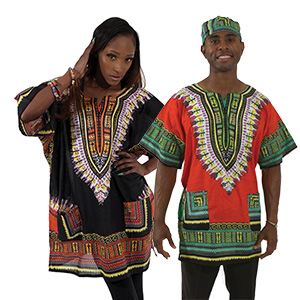On Tuesday of my last school spirit week in high school, my peers and I celebrated ‘Heritage Day’ by donning pieces of attire symbolic of our cultural backgrounds. As a member of the student government at the time, I had helped brainstorm the concept behind this particular spirit day. It was intended to be unifying in the sense that everyone would be able to celebrate his or her personal heritages on a single day, together. Unfortunately, some students missed the celebration memo and decided to sham the cultures of others.
I didn’t notice the looming issue until after the school day had ended and I was at track practice. Drexlar, my good friend and one of the most easy-going people I know was noticeably upset. As it turns out, there were a few white girls who had come to school wearing dashikis, which are traditional African tops. Though they are home to Africa, dashikis emerged on the market in America during the 1960s as a symbol of combat against social disrespect towards African Americans. The girls from my school wore African dashikis, but they did not display honor for the historical context that exists behind the fabric. Instead, they headed to social media, posting their photos in their dashikis with ignorant captions mentioning “jungles.”
Seeing my friend’s culture being appropriated and the effect that it had on her opened my eyes to the severe problem that exists in our society. Today I’m writing in attempt to help differentiate between cultural appreciation and cultural appropriation.
The line drawn between these two terms is definitely a fine one. According to Merriam-Webster, appreciation is defined as “a feeling or expression of admiration, approval, or gratitude.” That definition makes me feel warm and happy inside. Appropriation, however, is defined as “the act or instance of taking exclusive possession.” This definition makes me feel susceptible and powerless.
Perhaps the finest confliction of appreciation and appropriation exists as the dreadlock debacle. If you are not familiar with this issue, refer here for a quick and concise synopsis of both sides of the conflict.
After learning about the dreadlock debate, many people might inquire, “Then why are perms on ethnic individuals not appropriation?” Well, the concept behind a perm is to reform the natural shape of someone’s hair, making it more tame and manageable. Before someone can go ahead and pin this as appropriation, however, some logistics need to be considered. As established by many research studies including this sociology study concerning the role race plays in employment, a minority struggle is still present in the workforce. The rate at which employers display preference of white employees over black employees ranges from 50% to 240%. To ease this statistic and enhance their marketability for employment, black individuals often seek out perms in order to appear more professional. The point here, however, isn’t to dwell over hairstyles. The dialogue regarding hair is just a tangible example that lends to the larger, underlying problem: widespread acceptance of casual cultural appropriation.
For example, did you know that in 2016 the brand Emmaatan attempted to market a spray “tan” that touched hues far darker than tan? The controversial product was manufactured so that white women could artificially dye their skin dark shades of “chocolate” and “onyx.” This product literally opened a portal through which people could decide to change their skin color with the spritz of a can without adopting any of the other attributes that come with belonging to a specific race.
Similarly, cultural war bonnets or headdresses were created by Sioux American Indians to demonstrate reverence for courageous warriors and tribal chiefs. In fact, the honoree wearing the headdress acquired its feathers one at a time, receiving a new one with each demonstration of courage. When people wear imitations of this deeply rooted traditional artifact as a Halloween costume or to go to a festival because it looks “hipster,” they are ignorantly implying that an ordinary individual without any ties to Native American culture is equivalent to a celebrated, selfless tribal leader.
Undeniably, however, there are some instances in which people truly recognize the value of another culture and would like to observe it in their own lives in a respectful manner, which I find to be beautiful. When it comes down to pinpointing the location of the line that separates appreciation and appropriation, it’s all about evaluating intentions.
Instead of placing the major focus on how we style our hair or the clothes with which we cover our bodies, we should hone into what inspires us. For example, if a girl is born into a Spanish family but finds herself growing up in Istanbul, she is immersed in Turkish culture and of course she should accept and embrace Turkish customs. If a white boy has a large group of Indian friends who invite him to attend a garba event, he should accept the offer with respect and seize the opportunity to learn more of his friends’ culture. There is no need to deny inspiration from other cultures so long as it is accompanied with respect.
So before you wear a dashiki to school or borrow your best friend’s saree, educate yourself on the historical aspects, both good and bad, that are enrooted in these cultural clothing items. The same goes for other displays of custom: hairstyles, makeup, rituals, activities, social gatherings, art, or music. Just because something may appear beautiful does not mean that it has always been so. I have found that more times than you’d believe, cultural components are linked to historical hardship that needed to be overcome. If you want to take part in something that is symbolic of a culture other than your own, be sure to represent the culture wholly and honestly while also reaping its fruits.







Hi Caitlin,
Your post about differentiating between appreciation and appropriation was very interesting and pretty informative. While I’m aware of the concept and have heard conversations about the matter, I wasn’t exactly sure what the discussion was about. After reading your post, I have a much better understanding of the difference between cultural appropriation and cultural appreciation. In addition, I thought that your examples were great. Using the personal story to lead into the greater concept was a nice touch. It made me reflect on past spirit days when I was in school and if I had possibly been guilty of cultural appropriation.
With that said, after reading your article about the difference between the two terms, one question did come to mind: How do we regulate or ensure that people are not disrespecting other cultures through cultural appropriation? Educating people about the difference between the terms is definitely a great start. However, I wonder what we can do further to ensure that people are not unconsciously disrespecting other cultures. Maybe the next step would be having more open discussions about culture in the classroom or offering a cultural exploration class in school. Through open, genuine discussions, I would hope that thoughts, concerns, and experiences could be shared in a safe setting that would foster a more sensitive community when it comes to culture.
Because I think that schools can have a significant impact on the way that young people act, speak, perceive the word, and so on, I decided to search for some tools and resources about addressing cultural appropriation in the classroom. According to an article published by Education Week, a great way to start the conversation is through Halloween costumes. Because many students dress up for Halloween, they’ll be able to relate to the situation and have some prior knowledge to draw from when having the conversation about the issue. In addition, having “the challenging conversations” and “clearing up misconceptions” were also recommendations.
Overall, I thought that your blog post was great, because I learned a lot and was offered a new perspective. Thank you for taking the time to address this issue; the conversation needs to be had more often!
Happy writing,
Taylor M. Young